Diversity Management in Organizations: A Case Study of Woolworths
VerifiedAdded on 2023/01/18
|9
|2634
|55
Essay
AI Summary
This essay discusses diversity in the workplace, focusing on its importance for organizational reputation and profitability. It explores diversity issues such as gender inequality and communication barriers, highlighting their impact on organizational performance. Various management approaches, including equal opportunity and cross-cultural communication, are examined as strategies to address these issues. The essay uses Woolworths as a case study, showcasing the company's commitment to diversity and inclusion through initiatives like multicultural recognition and gender diversity programs. The analysis concludes that effective diversity management is crucial for long-term organizational success, fostering teamwork, cooperation, and enhanced organizational effectiveness.
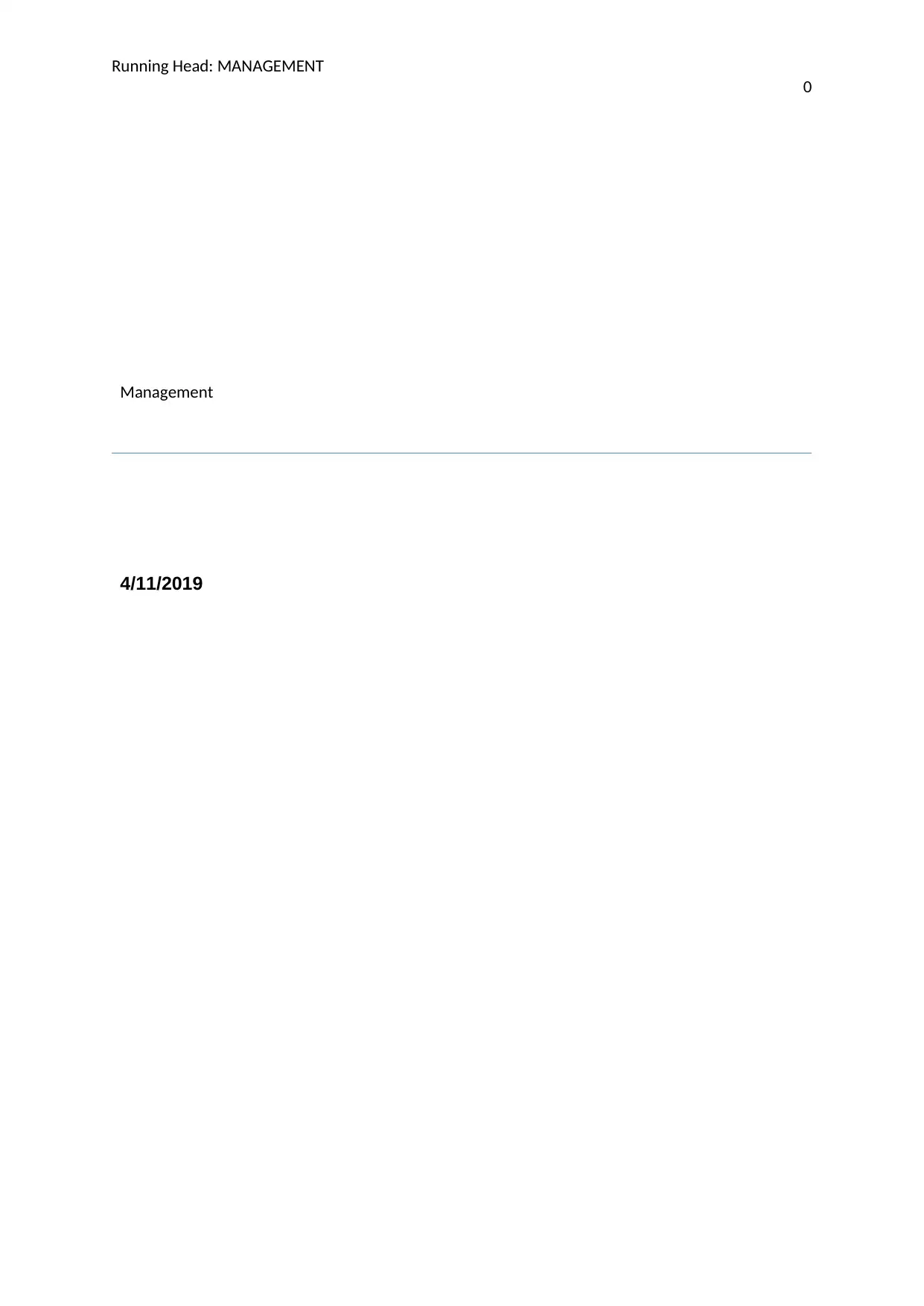
Running Head: MANAGEMENT
0
Management
4/11/2019
0
Management
4/11/2019
Paraphrase This Document
Need a fresh take? Get an instant paraphrase of this document with our AI Paraphraser
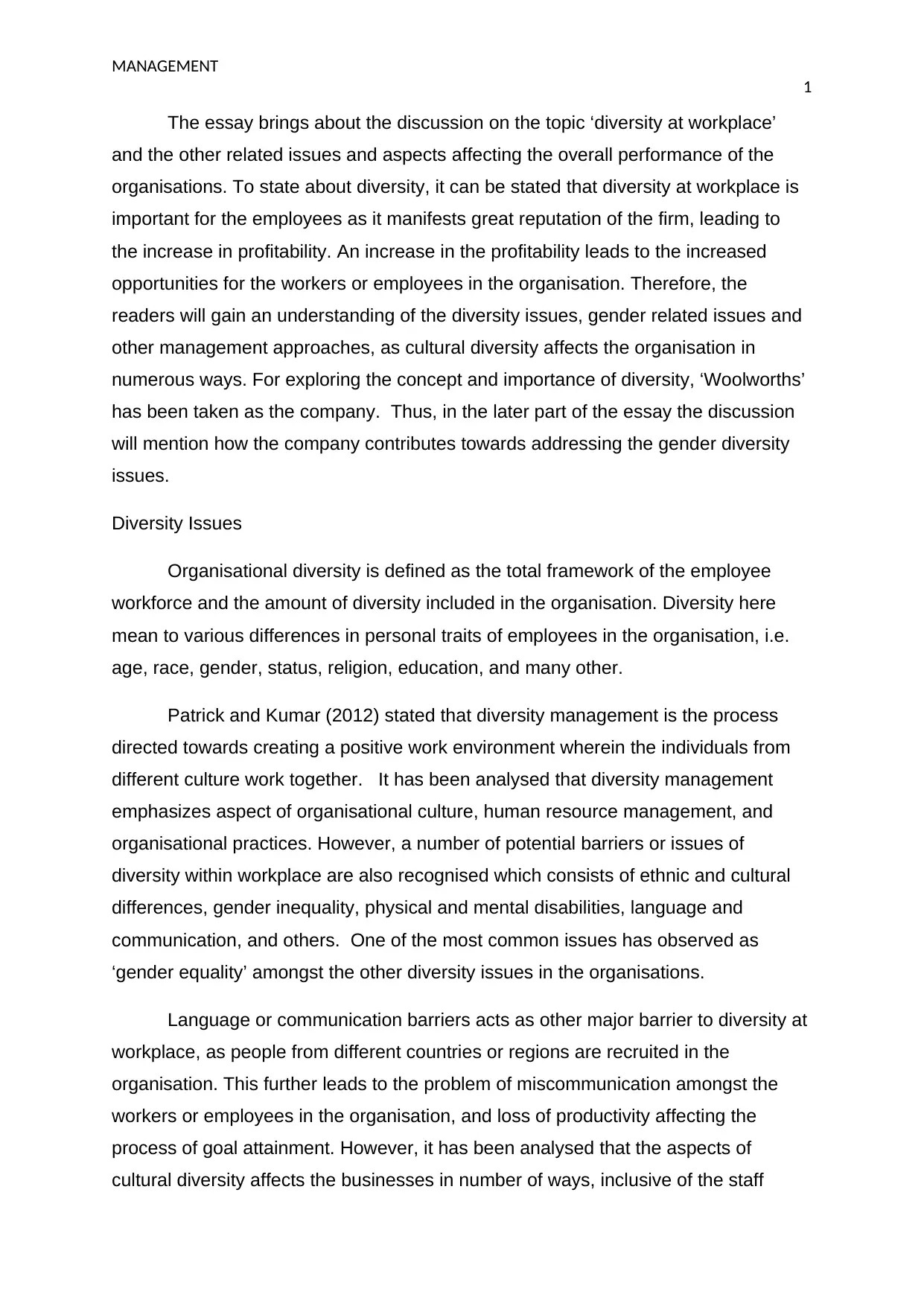
MANAGEMENT
1
The essay brings about the discussion on the topic ‘diversity at workplace’
and the other related issues and aspects affecting the overall performance of the
organisations. To state about diversity, it can be stated that diversity at workplace is
important for the employees as it manifests great reputation of the firm, leading to
the increase in profitability. An increase in the profitability leads to the increased
opportunities for the workers or employees in the organisation. Therefore, the
readers will gain an understanding of the diversity issues, gender related issues and
other management approaches, as cultural diversity affects the organisation in
numerous ways. For exploring the concept and importance of diversity, ‘Woolworths’
has been taken as the company. Thus, in the later part of the essay the discussion
will mention how the company contributes towards addressing the gender diversity
issues.
Diversity Issues
Organisational diversity is defined as the total framework of the employee
workforce and the amount of diversity included in the organisation. Diversity here
mean to various differences in personal traits of employees in the organisation, i.e.
age, race, gender, status, religion, education, and many other.
Patrick and Kumar (2012) stated that diversity management is the process
directed towards creating a positive work environment wherein the individuals from
different culture work together. It has been analysed that diversity management
emphasizes aspect of organisational culture, human resource management, and
organisational practices. However, a number of potential barriers or issues of
diversity within workplace are also recognised which consists of ethnic and cultural
differences, gender inequality, physical and mental disabilities, language and
communication, and others. One of the most common issues has observed as
‘gender equality’ amongst the other diversity issues in the organisations.
Language or communication barriers acts as other major barrier to diversity at
workplace, as people from different countries or regions are recruited in the
organisation. This further leads to the problem of miscommunication amongst the
workers or employees in the organisation, and loss of productivity affecting the
process of goal attainment. However, it has been analysed that the aspects of
cultural diversity affects the businesses in number of ways, inclusive of the staff
1
The essay brings about the discussion on the topic ‘diversity at workplace’
and the other related issues and aspects affecting the overall performance of the
organisations. To state about diversity, it can be stated that diversity at workplace is
important for the employees as it manifests great reputation of the firm, leading to
the increase in profitability. An increase in the profitability leads to the increased
opportunities for the workers or employees in the organisation. Therefore, the
readers will gain an understanding of the diversity issues, gender related issues and
other management approaches, as cultural diversity affects the organisation in
numerous ways. For exploring the concept and importance of diversity, ‘Woolworths’
has been taken as the company. Thus, in the later part of the essay the discussion
will mention how the company contributes towards addressing the gender diversity
issues.
Diversity Issues
Organisational diversity is defined as the total framework of the employee
workforce and the amount of diversity included in the organisation. Diversity here
mean to various differences in personal traits of employees in the organisation, i.e.
age, race, gender, status, religion, education, and many other.
Patrick and Kumar (2012) stated that diversity management is the process
directed towards creating a positive work environment wherein the individuals from
different culture work together. It has been analysed that diversity management
emphasizes aspect of organisational culture, human resource management, and
organisational practices. However, a number of potential barriers or issues of
diversity within workplace are also recognised which consists of ethnic and cultural
differences, gender inequality, physical and mental disabilities, language and
communication, and others. One of the most common issues has observed as
‘gender equality’ amongst the other diversity issues in the organisations.
Language or communication barriers acts as other major barrier to diversity at
workplace, as people from different countries or regions are recruited in the
organisation. This further leads to the problem of miscommunication amongst the
workers or employees in the organisation, and loss of productivity affecting the
process of goal attainment. However, it has been analysed that the aspects of
cultural diversity affects the businesses in number of ways, inclusive of the staff
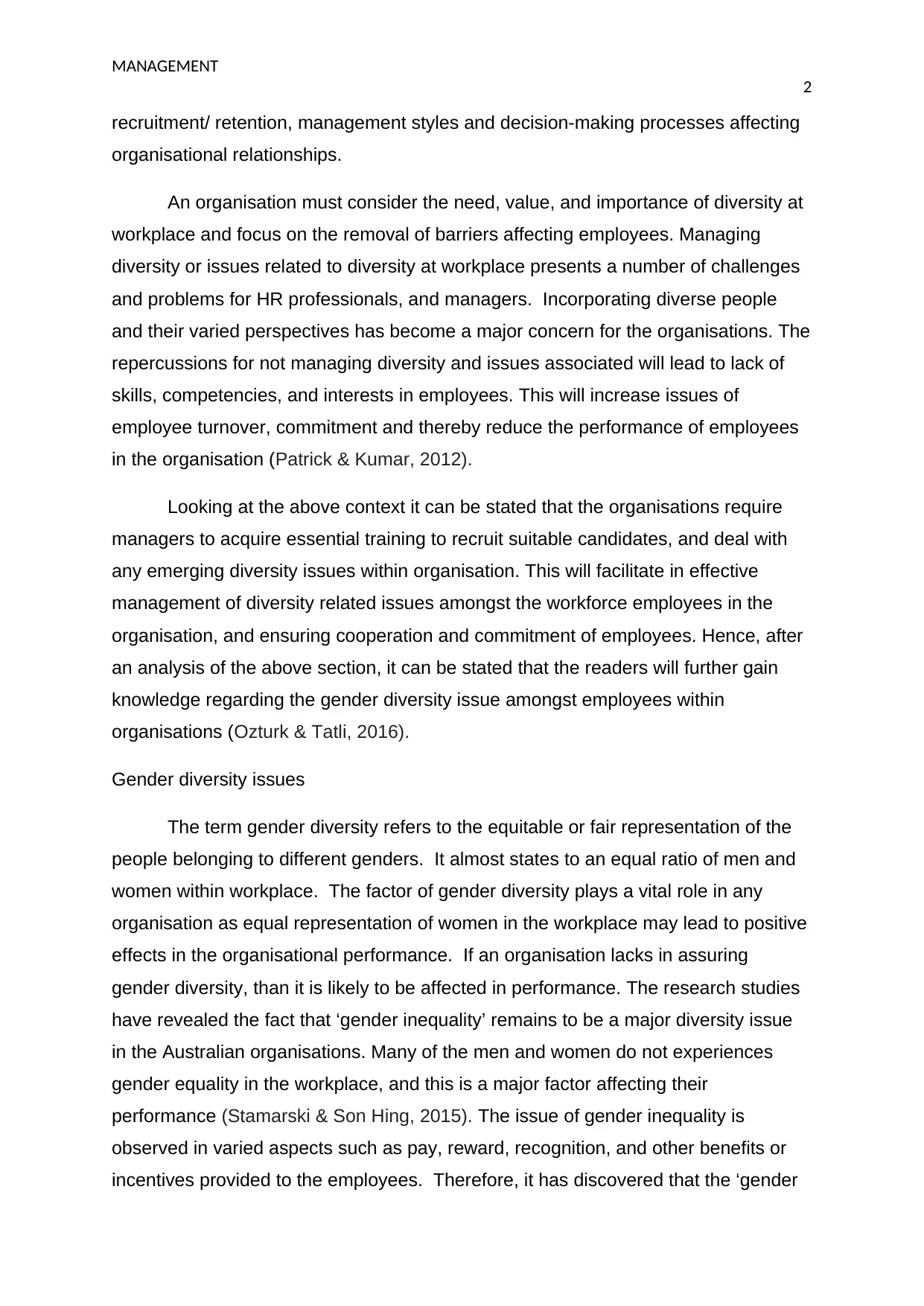
MANAGEMENT
2
recruitment/ retention, management styles and decision-making processes affecting
organisational relationships.
An organisation must consider the need, value, and importance of diversity at
workplace and focus on the removal of barriers affecting employees. Managing
diversity or issues related to diversity at workplace presents a number of challenges
and problems for HR professionals, and managers. Incorporating diverse people
and their varied perspectives has become a major concern for the organisations. The
repercussions for not managing diversity and issues associated will lead to lack of
skills, competencies, and interests in employees. This will increase issues of
employee turnover, commitment and thereby reduce the performance of employees
in the organisation (Patrick & Kumar, 2012).
Looking at the above context it can be stated that the organisations require
managers to acquire essential training to recruit suitable candidates, and deal with
any emerging diversity issues within organisation. This will facilitate in effective
management of diversity related issues amongst the workforce employees in the
organisation, and ensuring cooperation and commitment of employees. Hence, after
an analysis of the above section, it can be stated that the readers will further gain
knowledge regarding the gender diversity issue amongst employees within
organisations (Ozturk & Tatli, 2016).
Gender diversity issues
The term gender diversity refers to the equitable or fair representation of the
people belonging to different genders. It almost states to an equal ratio of men and
women within workplace. The factor of gender diversity plays a vital role in any
organisation as equal representation of women in the workplace may lead to positive
effects in the organisational performance. If an organisation lacks in assuring
gender diversity, than it is likely to be affected in performance. The research studies
have revealed the fact that ‘gender inequality’ remains to be a major diversity issue
in the Australian organisations. Many of the men and women do not experiences
gender equality in the workplace, and this is a major factor affecting their
performance (Stamarski & Son Hing, 2015). The issue of gender inequality is
observed in varied aspects such as pay, reward, recognition, and other benefits or
incentives provided to the employees. Therefore, it has discovered that the ‘gender
2
recruitment/ retention, management styles and decision-making processes affecting
organisational relationships.
An organisation must consider the need, value, and importance of diversity at
workplace and focus on the removal of barriers affecting employees. Managing
diversity or issues related to diversity at workplace presents a number of challenges
and problems for HR professionals, and managers. Incorporating diverse people
and their varied perspectives has become a major concern for the organisations. The
repercussions for not managing diversity and issues associated will lead to lack of
skills, competencies, and interests in employees. This will increase issues of
employee turnover, commitment and thereby reduce the performance of employees
in the organisation (Patrick & Kumar, 2012).
Looking at the above context it can be stated that the organisations require
managers to acquire essential training to recruit suitable candidates, and deal with
any emerging diversity issues within organisation. This will facilitate in effective
management of diversity related issues amongst the workforce employees in the
organisation, and ensuring cooperation and commitment of employees. Hence, after
an analysis of the above section, it can be stated that the readers will further gain
knowledge regarding the gender diversity issue amongst employees within
organisations (Ozturk & Tatli, 2016).
Gender diversity issues
The term gender diversity refers to the equitable or fair representation of the
people belonging to different genders. It almost states to an equal ratio of men and
women within workplace. The factor of gender diversity plays a vital role in any
organisation as equal representation of women in the workplace may lead to positive
effects in the organisational performance. If an organisation lacks in assuring
gender diversity, than it is likely to be affected in performance. The research studies
have revealed the fact that ‘gender inequality’ remains to be a major diversity issue
in the Australian organisations. Many of the men and women do not experiences
gender equality in the workplace, and this is a major factor affecting their
performance (Stamarski & Son Hing, 2015). The issue of gender inequality is
observed in varied aspects such as pay, reward, recognition, and other benefits or
incentives provided to the employees. Therefore, it has discovered that the ‘gender
⊘ This is a preview!⊘
Do you want full access?
Subscribe today to unlock all pages.

Trusted by 1+ million students worldwide
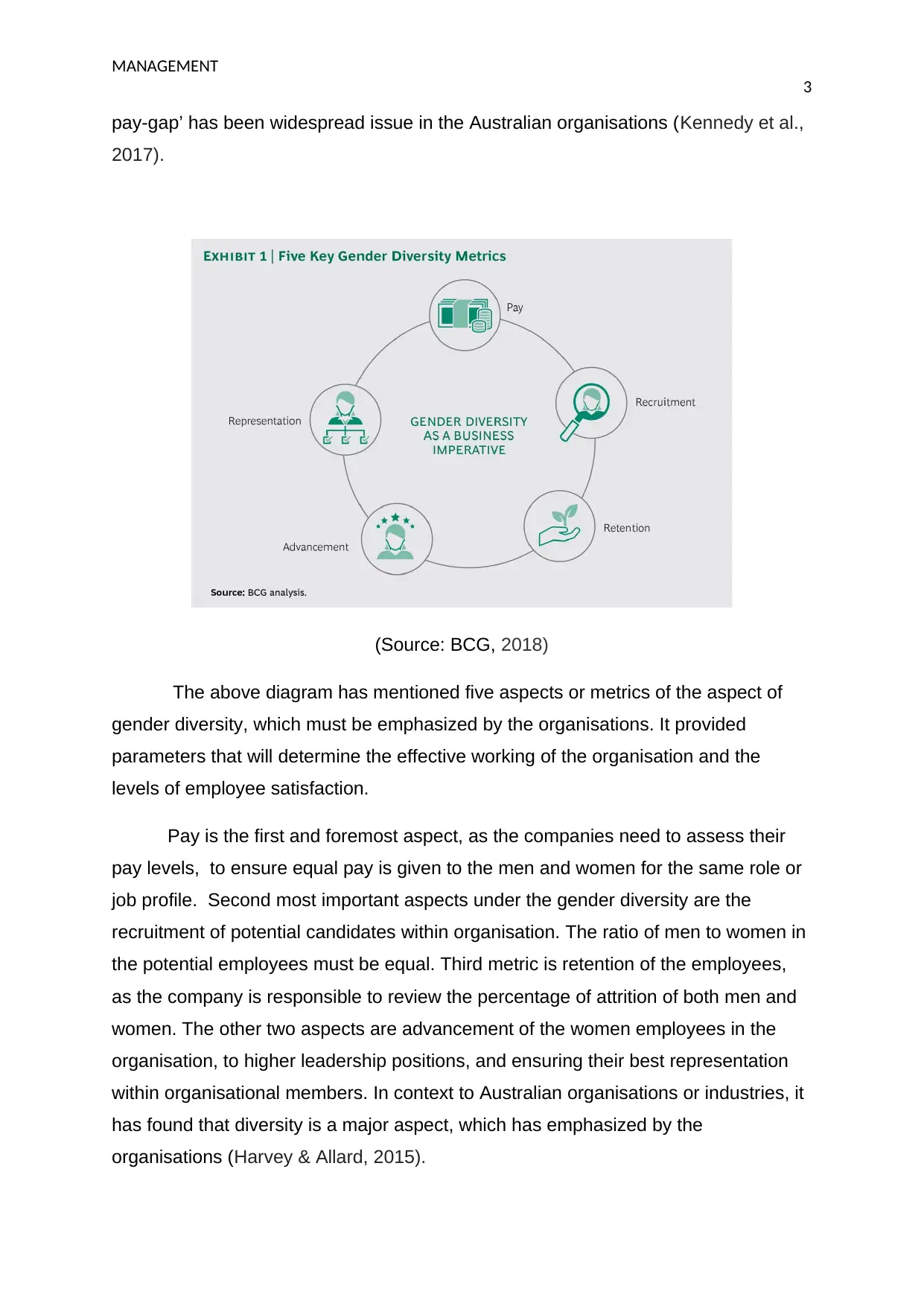
MANAGEMENT
3
pay-gap’ has been widespread issue in the Australian organisations (Kennedy et al.,
2017).
(Source: BCG, 2018)
The above diagram has mentioned five aspects or metrics of the aspect of
gender diversity, which must be emphasized by the organisations. It provided
parameters that will determine the effective working of the organisation and the
levels of employee satisfaction.
Pay is the first and foremost aspect, as the companies need to assess their
pay levels, to ensure equal pay is given to the men and women for the same role or
job profile. Second most important aspects under the gender diversity are the
recruitment of potential candidates within organisation. The ratio of men to women in
the potential employees must be equal. Third metric is retention of the employees,
as the company is responsible to review the percentage of attrition of both men and
women. The other two aspects are advancement of the women employees in the
organisation, to higher leadership positions, and ensuring their best representation
within organisational members. In context to Australian organisations or industries, it
has found that diversity is a major aspect, which has emphasized by the
organisations (Harvey & Allard, 2015).
3
pay-gap’ has been widespread issue in the Australian organisations (Kennedy et al.,
2017).
(Source: BCG, 2018)
The above diagram has mentioned five aspects or metrics of the aspect of
gender diversity, which must be emphasized by the organisations. It provided
parameters that will determine the effective working of the organisation and the
levels of employee satisfaction.
Pay is the first and foremost aspect, as the companies need to assess their
pay levels, to ensure equal pay is given to the men and women for the same role or
job profile. Second most important aspects under the gender diversity are the
recruitment of potential candidates within organisation. The ratio of men to women in
the potential employees must be equal. Third metric is retention of the employees,
as the company is responsible to review the percentage of attrition of both men and
women. The other two aspects are advancement of the women employees in the
organisation, to higher leadership positions, and ensuring their best representation
within organisational members. In context to Australian organisations or industries, it
has found that diversity is a major aspect, which has emphasized by the
organisations (Harvey & Allard, 2015).
Paraphrase This Document
Need a fresh take? Get an instant paraphrase of this document with our AI Paraphraser
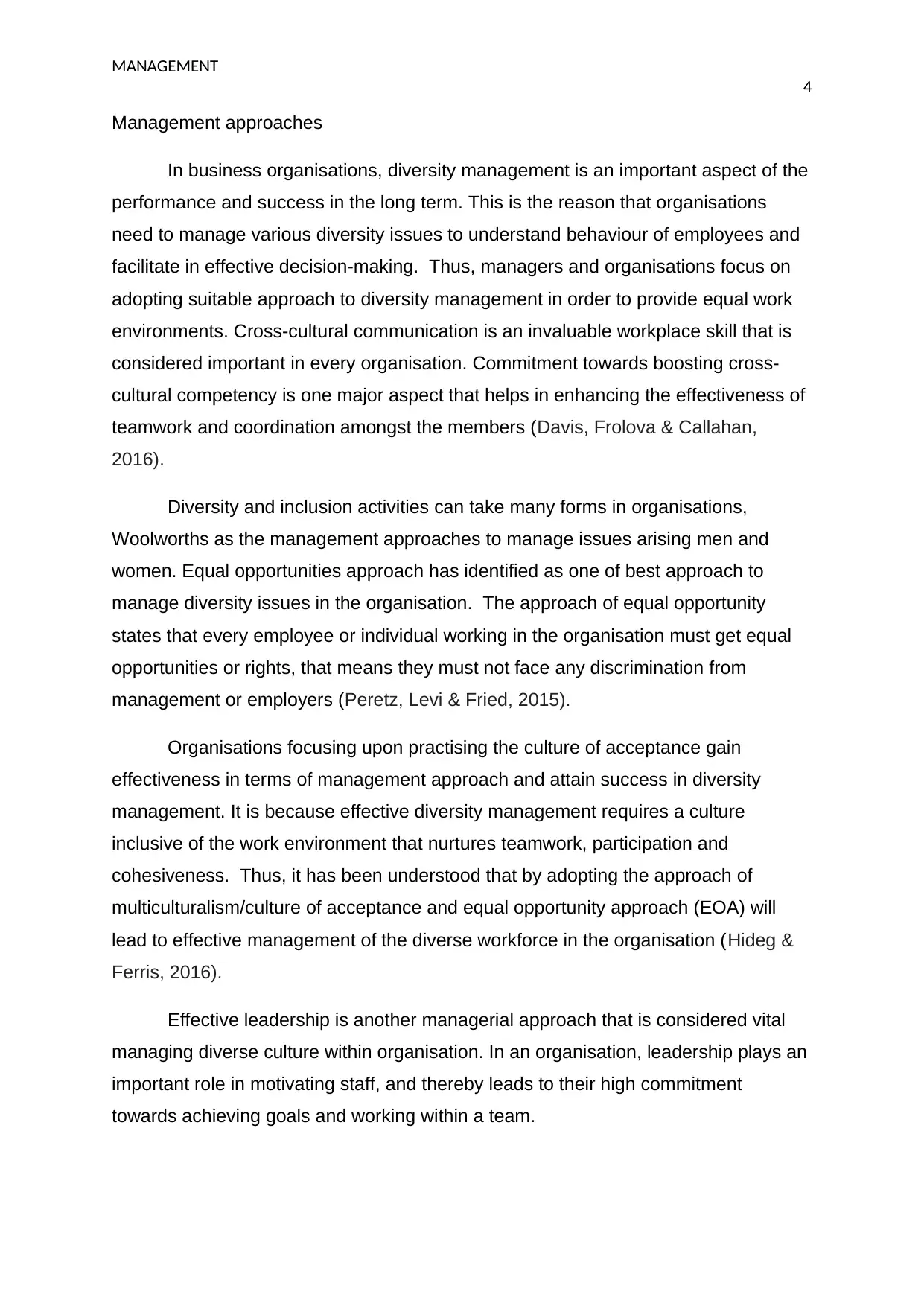
MANAGEMENT
4
Management approaches
In business organisations, diversity management is an important aspect of the
performance and success in the long term. This is the reason that organisations
need to manage various diversity issues to understand behaviour of employees and
facilitate in effective decision-making. Thus, managers and organisations focus on
adopting suitable approach to diversity management in order to provide equal work
environments. Cross-cultural communication is an invaluable workplace skill that is
considered important in every organisation. Commitment towards boosting cross-
cultural competency is one major aspect that helps in enhancing the effectiveness of
teamwork and coordination amongst the members (Davis, Frolova & Callahan,
2016).
Diversity and inclusion activities can take many forms in organisations,
Woolworths as the management approaches to manage issues arising men and
women. Equal opportunities approach has identified as one of best approach to
manage diversity issues in the organisation. The approach of equal opportunity
states that every employee or individual working in the organisation must get equal
opportunities or rights, that means they must not face any discrimination from
management or employers (Peretz, Levi & Fried, 2015).
Organisations focusing upon practising the culture of acceptance gain
effectiveness in terms of management approach and attain success in diversity
management. It is because effective diversity management requires a culture
inclusive of the work environment that nurtures teamwork, participation and
cohesiveness. Thus, it has been understood that by adopting the approach of
multiculturalism/culture of acceptance and equal opportunity approach (EOA) will
lead to effective management of the diverse workforce in the organisation (Hideg &
Ferris, 2016).
Effective leadership is another managerial approach that is considered vital
managing diverse culture within organisation. In an organisation, leadership plays an
important role in motivating staff, and thereby leads to their high commitment
towards achieving goals and working within a team.
4
Management approaches
In business organisations, diversity management is an important aspect of the
performance and success in the long term. This is the reason that organisations
need to manage various diversity issues to understand behaviour of employees and
facilitate in effective decision-making. Thus, managers and organisations focus on
adopting suitable approach to diversity management in order to provide equal work
environments. Cross-cultural communication is an invaluable workplace skill that is
considered important in every organisation. Commitment towards boosting cross-
cultural competency is one major aspect that helps in enhancing the effectiveness of
teamwork and coordination amongst the members (Davis, Frolova & Callahan,
2016).
Diversity and inclusion activities can take many forms in organisations,
Woolworths as the management approaches to manage issues arising men and
women. Equal opportunities approach has identified as one of best approach to
manage diversity issues in the organisation. The approach of equal opportunity
states that every employee or individual working in the organisation must get equal
opportunities or rights, that means they must not face any discrimination from
management or employers (Peretz, Levi & Fried, 2015).
Organisations focusing upon practising the culture of acceptance gain
effectiveness in terms of management approach and attain success in diversity
management. It is because effective diversity management requires a culture
inclusive of the work environment that nurtures teamwork, participation and
cohesiveness. Thus, it has been understood that by adopting the approach of
multiculturalism/culture of acceptance and equal opportunity approach (EOA) will
lead to effective management of the diverse workforce in the organisation (Hideg &
Ferris, 2016).
Effective leadership is another managerial approach that is considered vital
managing diverse culture within organisation. In an organisation, leadership plays an
important role in motivating staff, and thereby leads to their high commitment
towards achieving goals and working within a team.
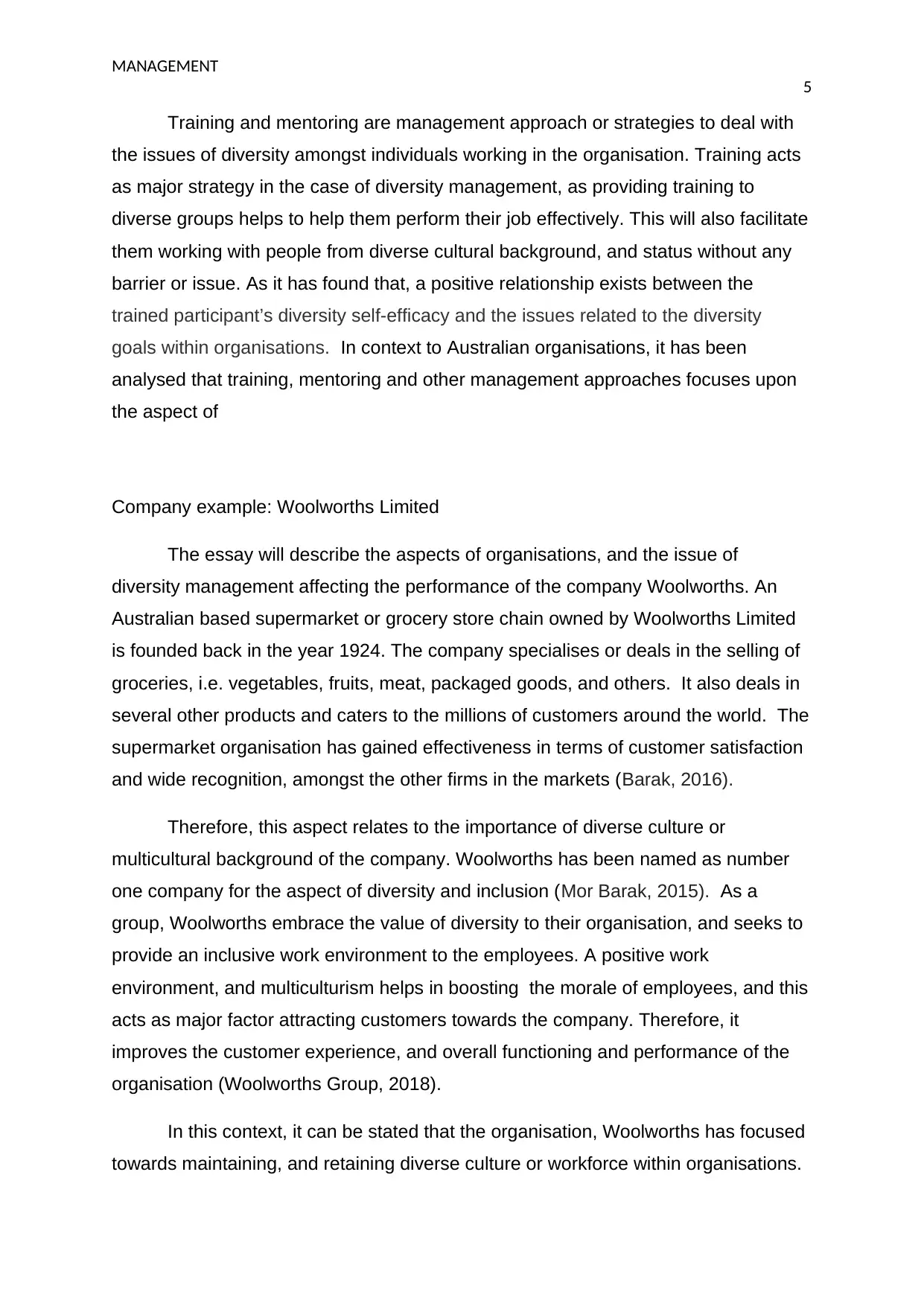
MANAGEMENT
5
Training and mentoring are management approach or strategies to deal with
the issues of diversity amongst individuals working in the organisation. Training acts
as major strategy in the case of diversity management, as providing training to
diverse groups helps to help them perform their job effectively. This will also facilitate
them working with people from diverse cultural background, and status without any
barrier or issue. As it has found that, a positive relationship exists between the
trained participant’s diversity self-efficacy and the issues related to the diversity
goals within organisations. In context to Australian organisations, it has been
analysed that training, mentoring and other management approaches focuses upon
the aspect of
Company example: Woolworths Limited
The essay will describe the aspects of organisations, and the issue of
diversity management affecting the performance of the company Woolworths. An
Australian based supermarket or grocery store chain owned by Woolworths Limited
is founded back in the year 1924. The company specialises or deals in the selling of
groceries, i.e. vegetables, fruits, meat, packaged goods, and others. It also deals in
several other products and caters to the millions of customers around the world. The
supermarket organisation has gained effectiveness in terms of customer satisfaction
and wide recognition, amongst the other firms in the markets (Barak, 2016).
Therefore, this aspect relates to the importance of diverse culture or
multicultural background of the company. Woolworths has been named as number
one company for the aspect of diversity and inclusion (Mor Barak, 2015). As a
group, Woolworths embrace the value of diversity to their organisation, and seeks to
provide an inclusive work environment to the employees. A positive work
environment, and multiculturism helps in boosting the morale of employees, and this
acts as major factor attracting customers towards the company. Therefore, it
improves the customer experience, and overall functioning and performance of the
organisation (Woolworths Group, 2018).
In this context, it can be stated that the organisation, Woolworths has focused
towards maintaining, and retaining diverse culture or workforce within organisations.
5
Training and mentoring are management approach or strategies to deal with
the issues of diversity amongst individuals working in the organisation. Training acts
as major strategy in the case of diversity management, as providing training to
diverse groups helps to help them perform their job effectively. This will also facilitate
them working with people from diverse cultural background, and status without any
barrier or issue. As it has found that, a positive relationship exists between the
trained participant’s diversity self-efficacy and the issues related to the diversity
goals within organisations. In context to Australian organisations, it has been
analysed that training, mentoring and other management approaches focuses upon
the aspect of
Company example: Woolworths Limited
The essay will describe the aspects of organisations, and the issue of
diversity management affecting the performance of the company Woolworths. An
Australian based supermarket or grocery store chain owned by Woolworths Limited
is founded back in the year 1924. The company specialises or deals in the selling of
groceries, i.e. vegetables, fruits, meat, packaged goods, and others. It also deals in
several other products and caters to the millions of customers around the world. The
supermarket organisation has gained effectiveness in terms of customer satisfaction
and wide recognition, amongst the other firms in the markets (Barak, 2016).
Therefore, this aspect relates to the importance of diverse culture or
multicultural background of the company. Woolworths has been named as number
one company for the aspect of diversity and inclusion (Mor Barak, 2015). As a
group, Woolworths embrace the value of diversity to their organisation, and seeks to
provide an inclusive work environment to the employees. A positive work
environment, and multiculturism helps in boosting the morale of employees, and this
acts as major factor attracting customers towards the company. Therefore, it
improves the customer experience, and overall functioning and performance of the
organisation (Woolworths Group, 2018).
In this context, it can be stated that the organisation, Woolworths has focused
towards maintaining, and retaining diverse culture or workforce within organisations.
⊘ This is a preview!⊘
Do you want full access?
Subscribe today to unlock all pages.

Trusted by 1+ million students worldwide
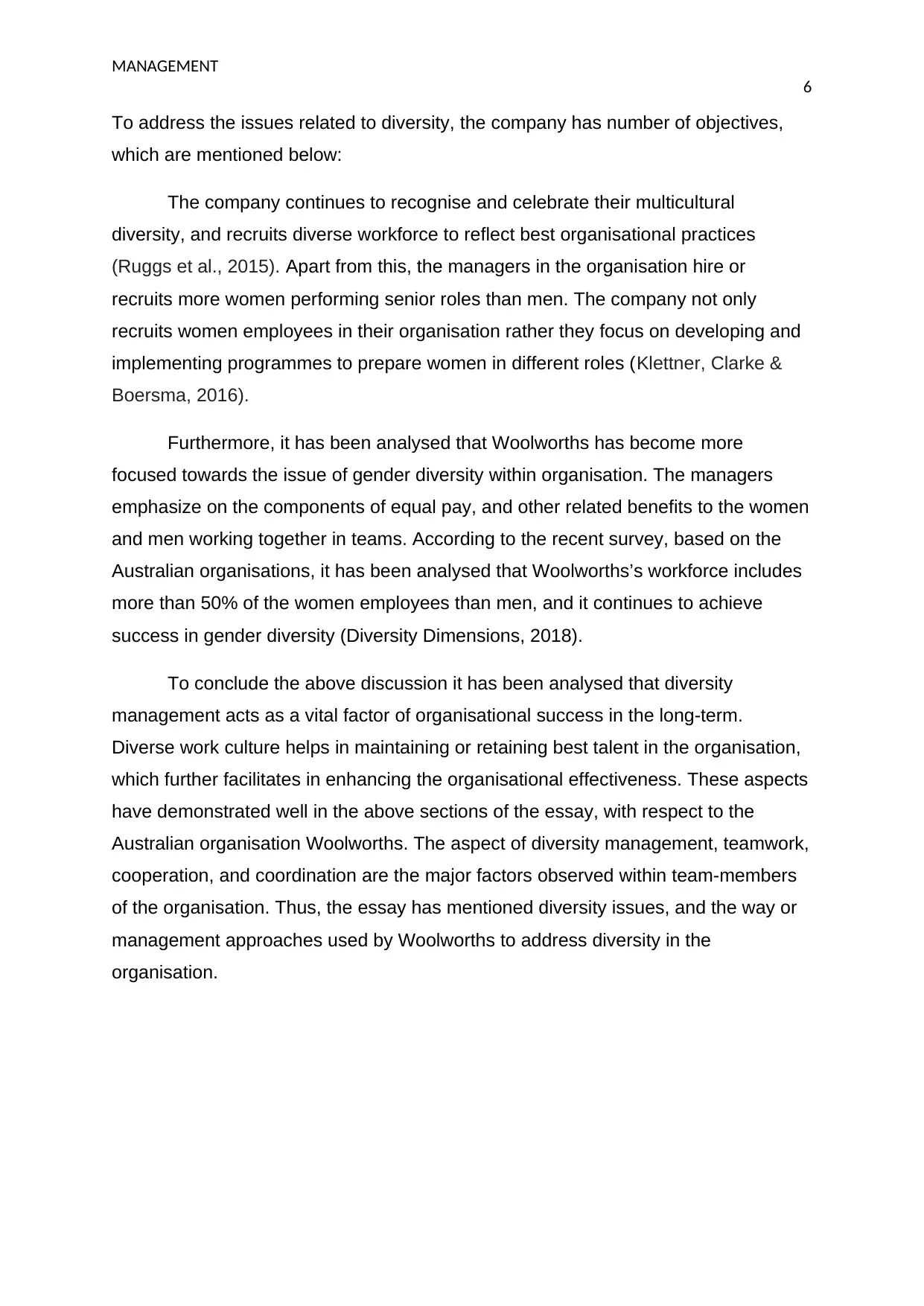
MANAGEMENT
6
To address the issues related to diversity, the company has number of objectives,
which are mentioned below:
The company continues to recognise and celebrate their multicultural
diversity, and recruits diverse workforce to reflect best organisational practices
(Ruggs et al., 2015). Apart from this, the managers in the organisation hire or
recruits more women performing senior roles than men. The company not only
recruits women employees in their organisation rather they focus on developing and
implementing programmes to prepare women in different roles (Klettner, Clarke &
Boersma, 2016).
Furthermore, it has been analysed that Woolworths has become more
focused towards the issue of gender diversity within organisation. The managers
emphasize on the components of equal pay, and other related benefits to the women
and men working together in teams. According to the recent survey, based on the
Australian organisations, it has been analysed that Woolworths’s workforce includes
more than 50% of the women employees than men, and it continues to achieve
success in gender diversity (Diversity Dimensions, 2018).
To conclude the above discussion it has been analysed that diversity
management acts as a vital factor of organisational success in the long-term.
Diverse work culture helps in maintaining or retaining best talent in the organisation,
which further facilitates in enhancing the organisational effectiveness. These aspects
have demonstrated well in the above sections of the essay, with respect to the
Australian organisation Woolworths. The aspect of diversity management, teamwork,
cooperation, and coordination are the major factors observed within team-members
of the organisation. Thus, the essay has mentioned diversity issues, and the way or
management approaches used by Woolworths to address diversity in the
organisation.
6
To address the issues related to diversity, the company has number of objectives,
which are mentioned below:
The company continues to recognise and celebrate their multicultural
diversity, and recruits diverse workforce to reflect best organisational practices
(Ruggs et al., 2015). Apart from this, the managers in the organisation hire or
recruits more women performing senior roles than men. The company not only
recruits women employees in their organisation rather they focus on developing and
implementing programmes to prepare women in different roles (Klettner, Clarke &
Boersma, 2016).
Furthermore, it has been analysed that Woolworths has become more
focused towards the issue of gender diversity within organisation. The managers
emphasize on the components of equal pay, and other related benefits to the women
and men working together in teams. According to the recent survey, based on the
Australian organisations, it has been analysed that Woolworths’s workforce includes
more than 50% of the women employees than men, and it continues to achieve
success in gender diversity (Diversity Dimensions, 2018).
To conclude the above discussion it has been analysed that diversity
management acts as a vital factor of organisational success in the long-term.
Diverse work culture helps in maintaining or retaining best talent in the organisation,
which further facilitates in enhancing the organisational effectiveness. These aspects
have demonstrated well in the above sections of the essay, with respect to the
Australian organisation Woolworths. The aspect of diversity management, teamwork,
cooperation, and coordination are the major factors observed within team-members
of the organisation. Thus, the essay has mentioned diversity issues, and the way or
management approaches used by Woolworths to address diversity in the
organisation.
Paraphrase This Document
Need a fresh take? Get an instant paraphrase of this document with our AI Paraphraser
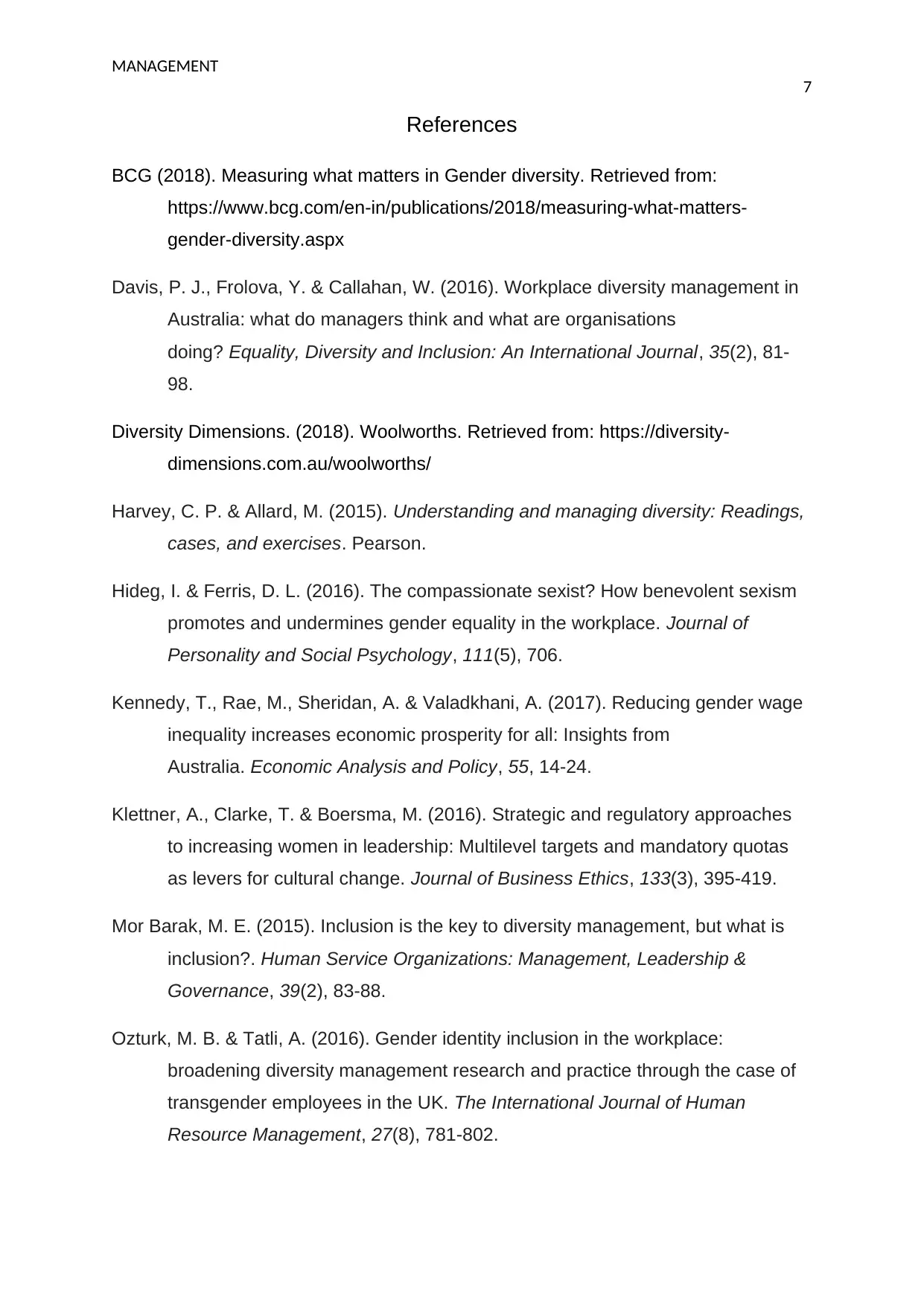
MANAGEMENT
7
References
BCG (2018). Measuring what matters in Gender diversity. Retrieved from:
https://www.bcg.com/en-in/publications/2018/measuring-what-matters-
gender-diversity.aspx
Davis, P. J., Frolova, Y. & Callahan, W. (2016). Workplace diversity management in
Australia: what do managers think and what are organisations
doing? Equality, Diversity and Inclusion: An International Journal, 35(2), 81-
98.
Diversity Dimensions. (2018). Woolworths. Retrieved from: https://diversity-
dimensions.com.au/woolworths/
Harvey, C. P. & Allard, M. (2015). Understanding and managing diversity: Readings,
cases, and exercises. Pearson.
Hideg, I. & Ferris, D. L. (2016). The compassionate sexist? How benevolent sexism
promotes and undermines gender equality in the workplace. Journal of
Personality and Social Psychology, 111(5), 706.
Kennedy, T., Rae, M., Sheridan, A. & Valadkhani, A. (2017). Reducing gender wage
inequality increases economic prosperity for all: Insights from
Australia. Economic Analysis and Policy, 55, 14-24.
Klettner, A., Clarke, T. & Boersma, M. (2016). Strategic and regulatory approaches
to increasing women in leadership: Multilevel targets and mandatory quotas
as levers for cultural change. Journal of Business Ethics, 133(3), 395-419.
Mor Barak, M. E. (2015). Inclusion is the key to diversity management, but what is
inclusion?. Human Service Organizations: Management, Leadership &
Governance, 39(2), 83-88.
Ozturk, M. B. & Tatli, A. (2016). Gender identity inclusion in the workplace:
broadening diversity management research and practice through the case of
transgender employees in the UK. The International Journal of Human
Resource Management, 27(8), 781-802.
7
References
BCG (2018). Measuring what matters in Gender diversity. Retrieved from:
https://www.bcg.com/en-in/publications/2018/measuring-what-matters-
gender-diversity.aspx
Davis, P. J., Frolova, Y. & Callahan, W. (2016). Workplace diversity management in
Australia: what do managers think and what are organisations
doing? Equality, Diversity and Inclusion: An International Journal, 35(2), 81-
98.
Diversity Dimensions. (2018). Woolworths. Retrieved from: https://diversity-
dimensions.com.au/woolworths/
Harvey, C. P. & Allard, M. (2015). Understanding and managing diversity: Readings,
cases, and exercises. Pearson.
Hideg, I. & Ferris, D. L. (2016). The compassionate sexist? How benevolent sexism
promotes and undermines gender equality in the workplace. Journal of
Personality and Social Psychology, 111(5), 706.
Kennedy, T., Rae, M., Sheridan, A. & Valadkhani, A. (2017). Reducing gender wage
inequality increases economic prosperity for all: Insights from
Australia. Economic Analysis and Policy, 55, 14-24.
Klettner, A., Clarke, T. & Boersma, M. (2016). Strategic and regulatory approaches
to increasing women in leadership: Multilevel targets and mandatory quotas
as levers for cultural change. Journal of Business Ethics, 133(3), 395-419.
Mor Barak, M. E. (2015). Inclusion is the key to diversity management, but what is
inclusion?. Human Service Organizations: Management, Leadership &
Governance, 39(2), 83-88.
Ozturk, M. B. & Tatli, A. (2016). Gender identity inclusion in the workplace:
broadening diversity management research and practice through the case of
transgender employees in the UK. The International Journal of Human
Resource Management, 27(8), 781-802.
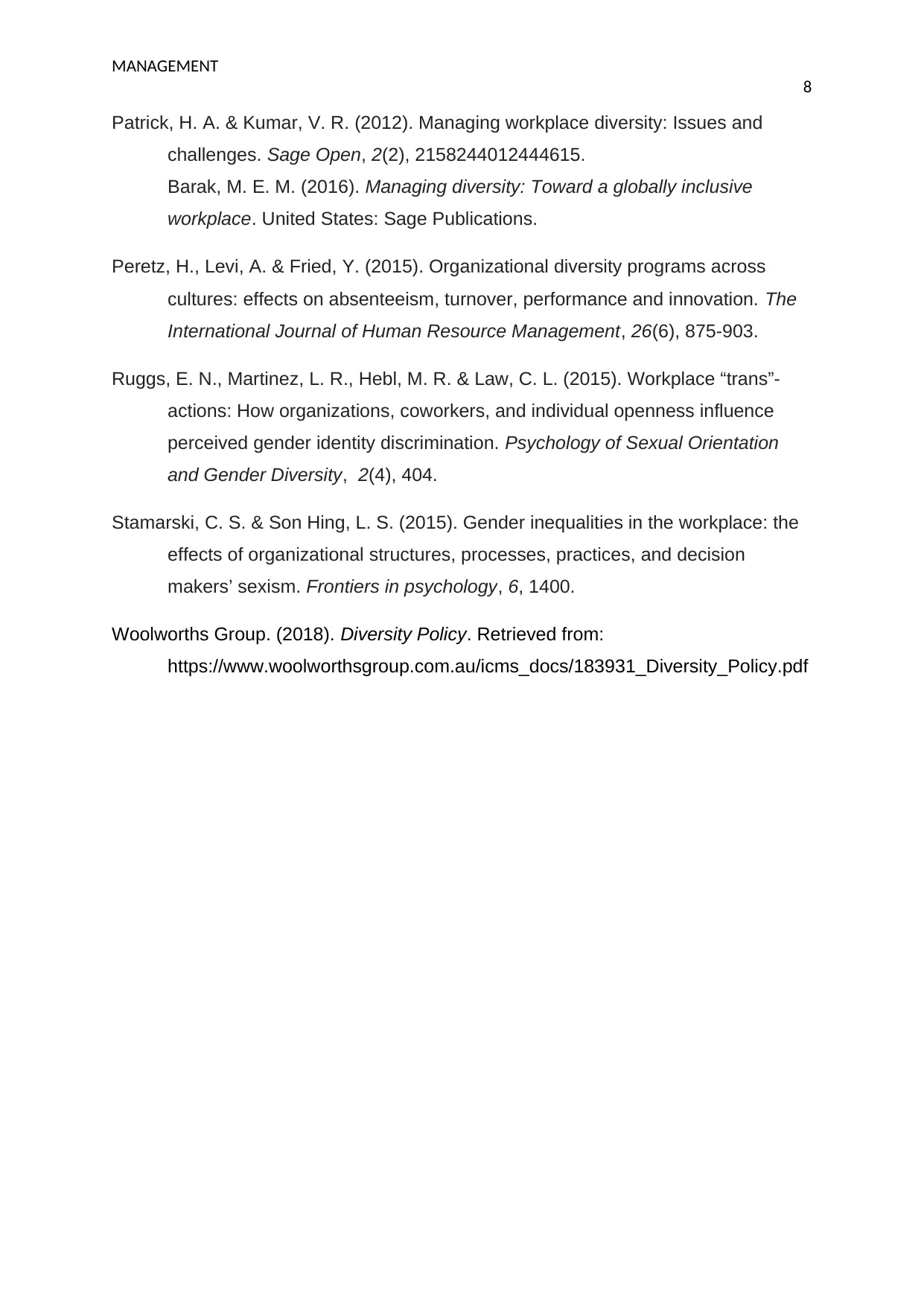
MANAGEMENT
8
Patrick, H. A. & Kumar, V. R. (2012). Managing workplace diversity: Issues and
challenges. Sage Open, 2(2), 2158244012444615.
Barak, M. E. M. (2016). Managing diversity: Toward a globally inclusive
workplace. United States: Sage Publications.
Peretz, H., Levi, A. & Fried, Y. (2015). Organizational diversity programs across
cultures: effects on absenteeism, turnover, performance and innovation. The
International Journal of Human Resource Management, 26(6), 875-903.
Ruggs, E. N., Martinez, L. R., Hebl, M. R. & Law, C. L. (2015). Workplace “trans”-
actions: How organizations, coworkers, and individual openness influence
perceived gender identity discrimination. Psychology of Sexual Orientation
and Gender Diversity, 2(4), 404.
Stamarski, C. S. & Son Hing, L. S. (2015). Gender inequalities in the workplace: the
effects of organizational structures, processes, practices, and decision
makers’ sexism. Frontiers in psychology, 6, 1400.
Woolworths Group. (2018). Diversity Policy. Retrieved from:
https://www.woolworthsgroup.com.au/icms_docs/183931_Diversity_Policy.pdf
8
Patrick, H. A. & Kumar, V. R. (2012). Managing workplace diversity: Issues and
challenges. Sage Open, 2(2), 2158244012444615.
Barak, M. E. M. (2016). Managing diversity: Toward a globally inclusive
workplace. United States: Sage Publications.
Peretz, H., Levi, A. & Fried, Y. (2015). Organizational diversity programs across
cultures: effects on absenteeism, turnover, performance and innovation. The
International Journal of Human Resource Management, 26(6), 875-903.
Ruggs, E. N., Martinez, L. R., Hebl, M. R. & Law, C. L. (2015). Workplace “trans”-
actions: How organizations, coworkers, and individual openness influence
perceived gender identity discrimination. Psychology of Sexual Orientation
and Gender Diversity, 2(4), 404.
Stamarski, C. S. & Son Hing, L. S. (2015). Gender inequalities in the workplace: the
effects of organizational structures, processes, practices, and decision
makers’ sexism. Frontiers in psychology, 6, 1400.
Woolworths Group. (2018). Diversity Policy. Retrieved from:
https://www.woolworthsgroup.com.au/icms_docs/183931_Diversity_Policy.pdf
⊘ This is a preview!⊘
Do you want full access?
Subscribe today to unlock all pages.

Trusted by 1+ million students worldwide
1 out of 9
Related Documents
Your All-in-One AI-Powered Toolkit for Academic Success.
+13062052269
info@desklib.com
Available 24*7 on WhatsApp / Email
![[object Object]](/_next/static/media/star-bottom.7253800d.svg)
Unlock your academic potential
Copyright © 2020–2025 A2Z Services. All Rights Reserved. Developed and managed by ZUCOL.





